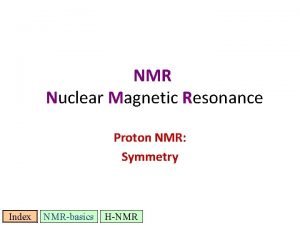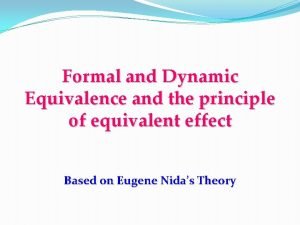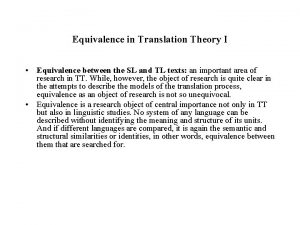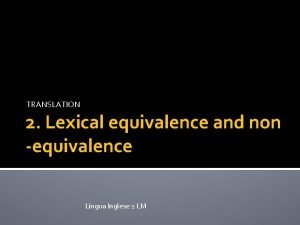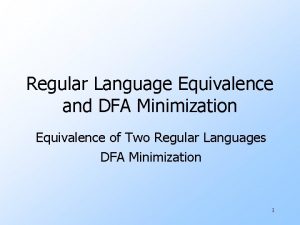Equivalence The many different definitions of equivalence in














- Slides: 14

Equivalence

The many different definitions of equivalence in translation fall broadly into one of two categories: they are either descriptive or prescriptive. Descriptively, 'equivalence' denotes the relationship between ST features and TT features that are seen as directly corresponding to one another, regardless of the quality of the TT.

Thus, descriptively, the following utterances are equivalents ﻣﻤﻨﻮﻉ ﺍﻟﺪﺧﻮﻝ forbidden is the entrance ﻣﻊ ﺍﻟﺴﻼﻣﺔ with the well-being :

Prescriptively, 'equivalence' denotes the relationship between an SL expression and the canonic TL rendering of it as required , for example, by a teacher. So, prescriptively, the following pairs of utterances are equivalents: ﻣﻤﻨﻮﻉ ﺍﻟﺪﺧﻮﻝ No entry ﻣﻊ ﺍﻟﺴﻼﻣﺔ goodbye

An influential variant (form) of prescriptive equivalence is the 'dynamic equivalence' suggested by Nida. This is based on the 'principle of equivalent effect' , which states that “the relationship between receptor and message should be substantially the same as that which existed between the original receptors and the message”(Nida 1964: 159)

Nida's view does have real attractions: 1. There all sorts of reasons - reasons of grammar, idiom, context, genre, etc. - why a translator might not want to translate a given expression literally. 2. Who is to know what the relationship between ST message and source-culture receptors is? For that matter, is it reasonable to speak of the relationship, as if there were only one: are there not as many relationships as there are receptors?

A good example of the problematicity of achieving an equivalent effect in Arabic>English translation is the translation of a piece of ancient Arabic poetry, such as ﻣﻌﻠﻘﺔ ﻟﺒﻴﺪ

Even in principle, it seems impossible to achieve in an English translation the effect created by ﻣﻌﻠﻘﺔ ﻟﺒﻴﺪ on the original audience of the poem, i. e. the Arabs of pre-Islamic Arabia. In fact, it seems impossible even to determine what these effects might have been. Equally, it seems almost certain that the effects achieved on a modem Arabic audience will be quite different from those achieved on the original audience

All this illustrates the dangers in the use of the term 'equivalence‘ to imply 'sameness' , as it does in logic, mathematics. In mathematics, an equivalent relationship is objective, incontrovertible and, crucially, reversible. In translation, however, such unanimity and such reversibility are unthinkable for any but the very simplest of texts - and even then, only in terms of denotative meaning

For example, if ﻫﻞ ﺃﻌﺠﺒﺘﻚ ﻣﺼﺮ؟ translates as 'Do you like Egypt? ', will backtranslation (that is, translating a TT back into the SL) automatically give, or ﻫﻞ ﺃﻌﺠﺒﺘﻚ ﻣﺼﺮ؟ will it give. ؟ or ﻫﻞ ﺗﻌﺠﺒﻚ ﻣﺼﺮ؟ . .

The answer depends, as it always does in translation matters, on context - both the context of the ST utterance and that of the TT utterance. The simplest of contexts is usually enough to inhibit the reversibility that is crucial to equivalence in the mathematical sense.

We have found it useful, both in translating and in teaching translation, to avoid an absolutist ambition to maximize sameness between ST and TT, in favour of a relativist ambition to minimize difference : to look not for what is to be put into the TT, but for what one might save from the ST.

Because maximizing sameness is not what the translator is looking for, it is more realistic, and more productive, to start by admitting that, because SL and TL are fundamentally different, the transfer from ST to TT inevitably entails difference - that is, loss.

Translation loss
 What is globalisation definition
What is globalisation definition Enantiotopic vs diastereotopic
Enantiotopic vs diastereotopic Examples of formal equivalence
Examples of formal equivalence Equivalence and equivalent effect
Equivalence and equivalent effect Different types of equivalence in translation
Different types of equivalence in translation Thermosoftening plastics examples
Thermosoftening plastics examples Flame test principle
Flame test principle Sound will travel at different speeds in different mediums.
Sound will travel at different speeds in different mediums. Library.thinkquest.org 19537
Library.thinkquest.org 19537 Cultural relarivism
Cultural relarivism Different angle different story
Different angle different story Acids and bases have two different faces
Acids and bases have two different faces Manufactured boards examples
Manufactured boards examples Things that make us different
Things that make us different Argumenterande tal struktur
Argumenterande tal struktur

